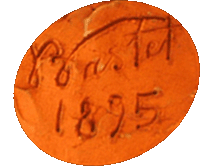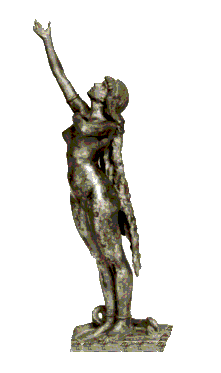His training
His works
Topics of his work
Raw Materials
Style and Ethics
Panorama
The
training
The education of Victorien Bastet was academic. As a pupil of
Aime Millet on Decorative Art courses, he was able to give his
wholehearted imagination and creativity.
The basis of progress for sculptors in the second half of the
XIXth century remained the competitions,ultimately leading to
medals from the jury of the French Artists Salon.
His
Works
Solenne Fétisson studied his work and retraced 312 sculptures.
307 original works and 430 variations in sizes, materials or
postures were discovered. A lot of them are still to be found
in press articles, private collections, auction sale or museum
wharehouses.
In Bastet's work the isolated figure prevailed; less than 10
of his works represented groups. He was a talented portrait
sculptor apreciated by his E.B.A masters. He produced a large
numbers of animated and characterful busts and earned a livelihood
with his art.His first works were low-relief "La vierge
à l'enfant ", " Le premier péché
" as well as 34 medallions, ornemental fireplaces
and 9 projects for funeral monuments. In 1886, he was commissionned
for 6 medallions to embellish the facade of the Toulon Museum
Today we kown of 147 medallions or busts portraits .
Topics
of his work
Woman was his favorite subject. About sixty statues declined
this topic with free inspirations, such “Fleur des
Champs”, which portrays a beautiful and healthy peasant
girl.
He made a lot of busts on the subject of childhood and adolescence.It
was the sculptural style of the time impelled by Rude, Carpeaux,
Injalbert (born in Béziers) “Petit joueur
de billes”
Like Dalou he became interested by small-trade sculpture, the
likes of “Petit ramoneur”, the rural “Catalane”,
“Bergere” or in 1881, during the Languedoc
phylloxera crisis, “La vigne mourante”
His Classical works modelled during his teaching years were
“Bacchus” or “Eros”…
Among Bastet's religious works were “Eve”and
“Ange”, subjects in fashion at the
end of the XIX century.
Victorien Bastet created only few funerary
works (5 on the topic of death), “Genie penché
sur un mourant”, “Douleur”,
but only the bust of “Mr. Bardou Job” decorated
his grave in 1894. He carved several posthumous busts, such
the one of his father in 1885 “Louis-Martin Bastet: 1818-1881”.
As regards to Decorative Arts, several sketches
were saved by his family. He probably was commissionned for
sculptural decoration in private residences for which he carved
fireplaces and doors. There were also models of funerary monuments,
several "Douleurs", but we have no tracks of their
final destination.
He practically abandoned the animal sculpture and only a "
Lapin aux aguets " is listed even if certain titles
"Cigale" and "Libellule"
made us believed otherwise.
At the time,influences were eclectic. The work
of Victorien Bastet was distinguished by classicism and conservative
idioms of the History of Sculpture. The busts of his customers
"Mrs Pourquery de Boisserin" or relatives
" Juliette Delorme "were handled in this
style.
But his work reflected the multiple influences
of his time with neo-romanticism and a return to classicism
at the end of the century. The romantic current corresponded
well to his ornamental artwork, by allowing all the whims in
candlesticks or pipes.
Some of his creations conveyed feelings by emphasizing facial
expressions and caught the subtle variations of light. He tried
to capture a specific human emotion as for "Faune",
"Premiere sensation " or " L'enfant
endormi ". The psychological analysis maybe genuine
"of a terrible look alike " dixit Armand
de Pontmartin.
From his studies at the Ecole des Beaux Arts he acquired great
drawing technics. A self-portrait realized when he was about
thirty years old revealed how talented he was as a painter.
His creations "Porteuse d'eau mauresque"
and "Salome" were inspired by Orientalism.
His most succesful work "Salammbô"
was inspired by the novel heroin of Flaubert very much in vogue
at the time.
He took inspiration from other novels such "Manon l'
Escaut" or "Esmeralda" of Victor
Hugo modelled after his wife Juliette.
The pervading historicism influences his "Guillaume
Tell". The operas "Carmen",and
"Névrose" were also symbolic works.
With the advances in science that the Industrial Revolution
inspired, he created busts like " La Comete"
or "L'etoile filante". On the other hand,
his commitment had been of religioussubjects as "La
Samaritaine" and 11 works treated that subject. The
only politic sculpture known today is a group about the Republic.
He did only 5 monuments often connected to Felibrige, such his
"Monument to Roumanille " in the Saint Martial public
garden of Avignon.
The
Raw Materials :
Victorian is a modeler: his sculpture were not realized
in life size. He worked with wood or clay that the manufacturers
of his village used for fireproof bricks. Some of his works
were made out of polished plaster. Others were melted bronze
sized up to 1.20 meter, as the bust of the marquess Fare
Alais. He often worked with the Barbedienne foundry.
The busts that he created for public buildings were all melted
in 1942. He experimented polychromatic and gilded bronze with
" La Comete ". His naturalism works were
made out of marble sculpted in workshops. "Le Bebe
qui dort " was mentioned in alabaster and the photographed
version of the sculpture was rather marble.
Style and Ethics
The postures were sophisticated as in "Lla vigne mourante
", "Biblis" or "Eve".
The flight from reality had first surfaced in Romanticism but
flowered again and reached its limits toward the end of the
19th century."La comète" and the heroic
nude sculpture the "Danseuse", in 1897, characterized
V. Bastet's work during this period.
His work reminded the excessive fastidious refinement of
the 18th century sculptural style as in " Grain
de Beauté".
Unlike his contemporary Felix Charpentier,
Victorien suffered a lack of recognition even in his native
area. He liked to consider himself as an artisan, a lover
of " Beauty", rather than an artist. His conception
of Art forbided him to model with bronze which would have
popularized his work.
His strong beliefs in front of this distribution plunged
him into financial harrassments when his sickness became
invalidating. For his offspring many of his works are henceforth
unknown. The artist never sought fame. The press people
and the public knew more about his sculptures than of the
creator.




